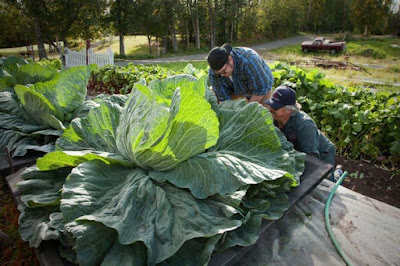Plants That Grow Well in Alaskan Vegetable Gardens
 Alaska spells snow and cold to many, but the land of the midnight sun holds some gardening surprises. The cool, short growing season and low soil temperatures require choosing vegetable varieties suited to Alaskan conditions, but they also mean fewer of insect pests or diseases found in warmer climes. Savvy gardeners understand that long summer days bring fast growth, while cool nights increase vegetable sweetness. With the right support and timing, most popular vegetables flourish in Alaskan sun.
Alaska spells snow and cold to many, but the land of the midnight sun holds some gardening surprises. The cool, short growing season and low soil temperatures require choosing vegetable varieties suited to Alaskan conditions, but they also mean fewer of insect pests or diseases found in warmer climes. Savvy gardeners understand that long summer days bring fast growth, while cool nights increase vegetable sweetness. With the right support and timing, most popular vegetables flourish in Alaskan sun.Cool-Season Crops
Not surprisingly, cool-season crops perform well in annual vegetable gardens throughout Alaska's growing regions. These vegetables tolerate low soil temperatures and grow vigorously once air temperatures reach 40 degrees Fahrenheit. Many can be planted in spring and fall, for double harvests. Cole-crops such as cabbage, cauliflower, broccoli, kale and Brussels sprouts -- all varieties of Brassica oleracea -- thrive in Alaskan conditions. Kale and parsnips (Pastinaca sativa) improve in flavor when nipped by frost. For radishes (Raphanus sativus), beets (Beta vulgaris) and spinach (Spinacia oleracea), stick with bolt-resistant varieties that won't go to seed too quickly during long summer days.
Warm-Season Selections
Vegetables that need air temperatures at 50 degrees or higher do well when Alaskan soils are warmed as well. Warm-season crops such as corn (Zea mays) and green beans (Phaseolus vulgaris) handle Alaskan conditions when soil is covered by clear plastic at planting. The plastic collects and holds solar heat in the soil, speeds germination, conserves soil moisture and extends the growing season. Black plastic and organic mulches slow soil warming in Alaska. Cucumbers (Cucumis sativus) and tomatoes (Lycopersicon esculentum) also benefit from high tunnels or row covers. Choose cold-tolerant, very early, determinate varieties to shorten the time to harvest and keep green tomato recipes at hand.
Tropical Treats
Even tropical vegetable varieties do well when grown as annuals in Alaskan gardens and given some extra loving care. Once air temperatures reach 60 degrees, even heat-loving vegetables, such as eggplant (Solanum melongena), melons (Cucumis melo) and peppers (Capsicum spp.), can handle Alaskan conditions. Start with large, healthy transplants and short-season varieties. Avoid peat pots, which resist breaking down in cool Alaskan soils, or remove them at planting time. Use clear plastic to warm the soil and high tunnels or row covers to protect crops from winds and cool overnight temperatures.
Alliums for Alaska
Often fall-planted in warmer climates, alliums require a fresh Alaskan approach. Non-hardy biennials and annuals, such as leeks (Allium porrum and Allium ampeloprasum) and onions (Allium cepa), won't survive Alaskan winters. Mature leeks require a long growing season, but spring planting still yields delicious baby leeks. Direct-seed green onions two weeks before the final expected frost, but use spring-planted sets for bulb onions. Hardneck garlics (Allium sativum var. ophioscorodonum), hardy biennials in USDA zones 3 through 8, withstand Alaska winters if protected by mulch or snow cover. Plant cloves in early fall for summer harvests.











Comments
Post a Comment